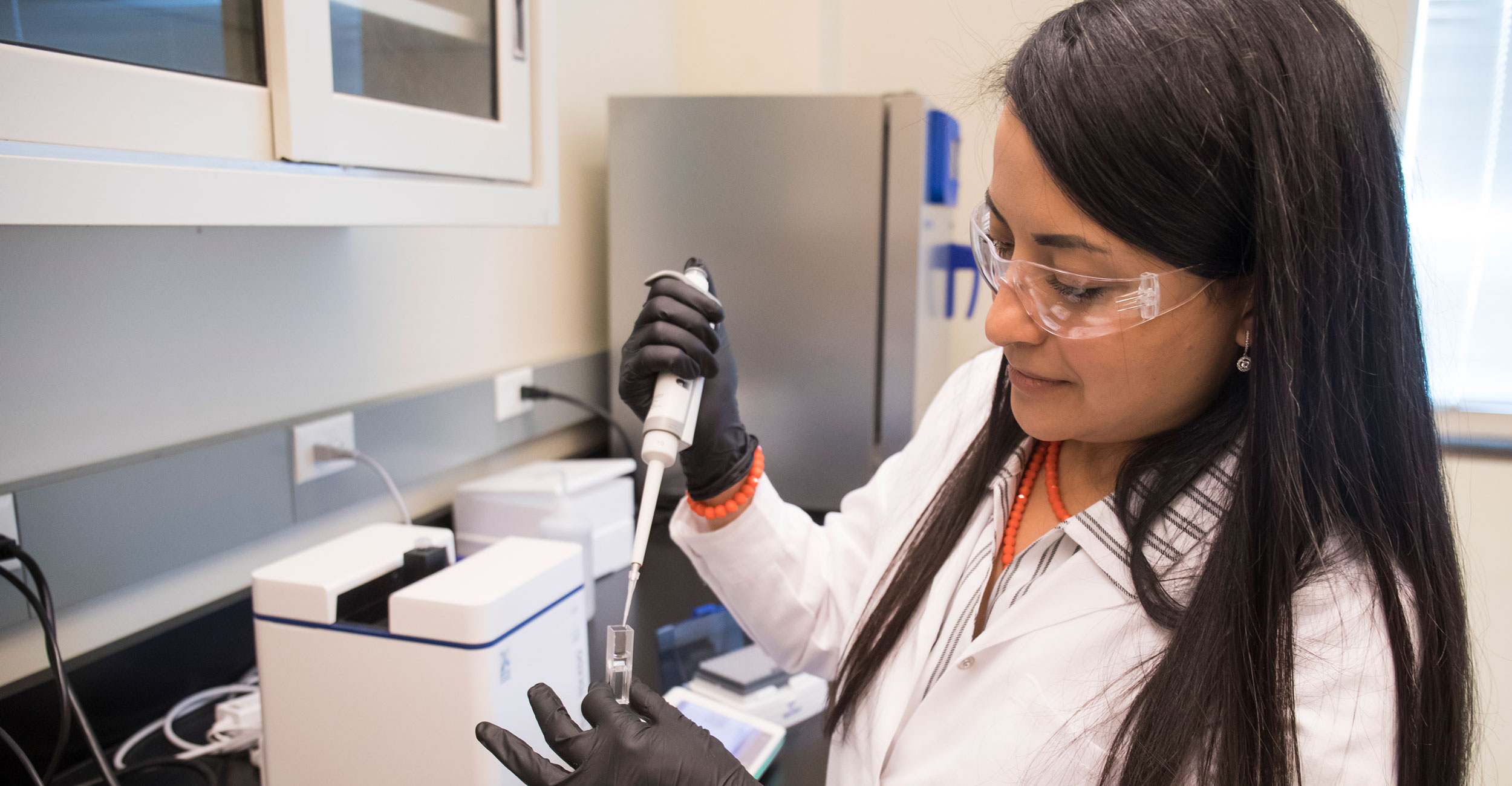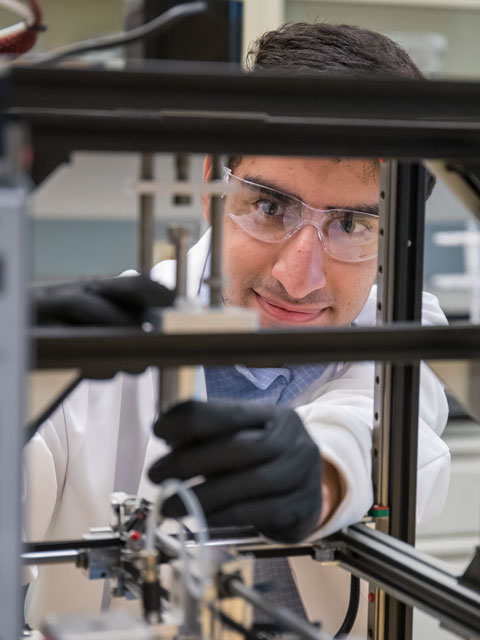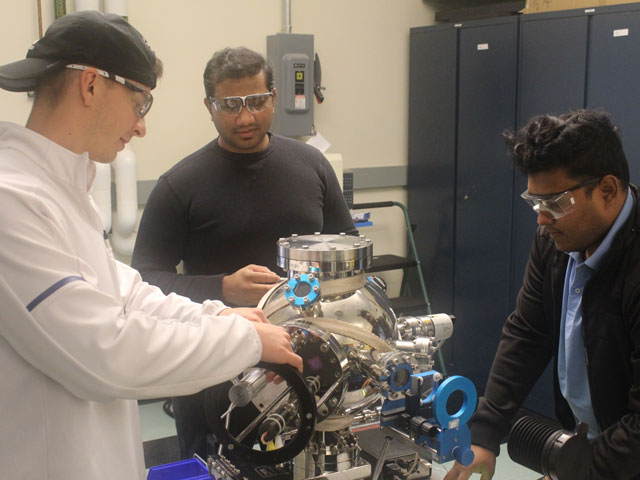
Small materials, big impact
Monday, January 10, 2022
Media Contact: Kristi Wheeler | Manager, CEAT Marketing and Communications | 405-744-5831 | kristi.wheeler@okstate.edu
For two research groups in CEAT, the future of science, engineering and technology could come in the form of nanotechnology.

A nanometer is one-billionth of a meter and to understand the subject of nanotechnology — which impacts nanoscale science, engineering and technology — you have to be able to understand and control matter at that scale.
At the nanoscale — anything between approximately 1 and 100 nanometers —gases, liquids and solids can exhibit unusual physical, chemical and biological properties, allowing for unique phenomena to take place resulting in novel applications. Nanotechnology involves the imaging, measuring, modeling and manipulating of matter at this scale.
“All spectrum of human life can be affected by the nanoscale,” said Dr. Shohreh Hemmati, an assistant professor in the College of Engineering, Architecture and Technology’s School of Chemical Engineering (CHE). “Different types of nanomaterial can be used in different and broad types of applications from biomedical applications to electronics and energy storage.”
Hemmati’s research focuses on developing and using nanotechnology for green innovation. More specifically, her research focuses on cost effective, environmentally safe methods of silver and palladium nanostructure creation for new transparent conductive flexible ecofriendly films (TCFEcoFs) fabrication.
“There are a broad range of applications in the study of silver and palladium nanostructures,” Hemmati said. “For example, some of the silver and palladium structures that we are producing can be used for renewable energy, electronics, biosensors, wastewater treatment, medicine and clinical equipment. But, our main focus is on manufacturing transparent conductive flexible ecofriendly films.”

Transparent conductive films (TCFs) are most commonly used in LED screens, LCD screens, touchscreen sensors, body sensors and cellphones. Her research team is trying to continuously produce metal nanostructures in a novel segmented millifluidic flow reactor (SMFR), while at the same time reducing the waste that is produced in the process. SMFRs are an important class of millifluidic reactors that have been developed to accurately manipulate nanomaterial synthesis.
Segmented flow is where there are two or more phases that do not form a homogeneous mixture when added together — such as water and oil — that produce droplets of solution.
Hemmati’s long-term goal is to utilize different millifluidic methods for the synthesis of metal nanostructures, as well as other nanomaterials. She wants to reduce the final cost of these nanostructures and nanomaterials by using the application of less expensive water-based reagents at lower reaction temperatures.
These methods will be tailored to control the morphology of nanostructures for specific practical applications in the future.
“We call our lab the Green Nanotechnology and Manufacturing Lab,” Hemmati said. “We call it this because green nanotechnology may include nanomanufacturing techniques and processes that are safe and environmentally and economically sustainable. There are deep connections between green nanotechnology, principles of green chemistry, green engineering and sustainability.”
The team is working to produce the nanostructures at lower temperatures compared to conventional batch or chemical processes and replace the organic solvents used in the conventional chemical processes with water based solvents which do not produce hazardous waste.
“We are incorporating the principles of green chemistry, green engineering and sustainability to produce these metal nanostructures in a cost-effective manner to make sure that they are economical and at the same time they are sustainable and producing less waste and hazardous material than other ways of producing nanometals,” Hemmati said.
One of the green approaches that the lab is taking is creating a template out of plants to produce these nanostructures.
Tobacco Mosaic Virus (TMV) is a virus that was named for one of the first plants that it was found in, but it can infect over 350 different species of plants. The virus has a rigid, rod-shape and once inside the plant cell, it disrupts the cells normal activity.
Barley Stripe Mosaic Virus (BSMV) is very similarly shaped to TMV but typically infects barley and wheat plant varieties.
Hemmati’s team — in collaboration with Dr. Josh Ramsey, a professor in CHE, and faculty members from Purdue University, as well as the University of Delaware — are using the virus-like particles from TMV and BSMV expressed in the bacterial system Escherichia coli, commonly known as E. coli, as a biotemplate for metal nanoparticle mineralization.
Virus-like particles are molecules that closely resemble viruses, but are non-infectious because they contain none of the virus’ genetic material.
“With the specific diameter and length created by the VLPs, we use these newly made rod-shaped templates and at low temperatures and using water as a solvent we can attach different metal nanostructures to the template,” Hemmati said. “When the template is removed we ideally have a structure in the specific dimensions and size that we are looking for specifically in nanoelectronics applications.”
While Hemmati’s lab looks for better ways to create nanometal structures, another lab in CEAT is working on getting nanomaterials to Mars.
Dr. Ritesh Sachan, an assistant professor in CEAT’s School of Mechanical and Aerospace Engineering , is leading a research project to invent new multi-element nanometals called high entropy alloy nanoparticles.
High entropy alloy nanoparticles have four or more elements connected into one structure, which gives them unique chemical and physical properties. Using the high entropy alloy nanoparticle’s unique structure, the team is designing several nanomorphologies that include nanoholes, nanomesh and different nanoparticles.
Nanohole and nanomesh refer to how the nanoparticles look or are shaped.
There are several applications of these nanomorphologies being used in future technologies including technologies that influence the structure and function of nanomaterials. One of the most important applications of nanomorphologies is their use in catalytic applications. Catalysis is the process in which the rate or outcome of a chemical reaction is influenced by the presence of a substance that is not consumed or changed during the reaction.
“We are aiming at using these catalytic applications for carbon dioxide reduction on Mars,” Sachan said. “Ninety-five percent of Mars’ environment is constituted by carbon dioxide, so we hope that our research will provide a desired breakthrough in the ability to reduce carbon dioxide for future energy applications.”
The field of research, regarding the catalysts for carbon dioxide reduction is very competitive due to the popular use of noble metals, which are metallic elements that show an outstanding resistance to chemical attack even at high temperatures.
According to an article written by NASA, research has shown that Mars contains noble metals within its mantle, or the layer of Mars that lies beneath its crust.
But noble metal technology is expensive.

“We believe our research will lead to the substitution of expensive noble metal technology with more cost-effective high entropy nanoscale systems,” Sachan said. “Since we have discovered a new family of metallic nanoparticles and a way to fabricate them, the field is wide-open to identifying applications that focus on structural, magnetic and thermal properties.”
To fabricate these nanomaterials, Sachan’s team uses an ultra-fast pulsed laser-induced dewetting method, where energetically unstable metal films break into nanodroplets by laser-induced heating.
This method is similar to how water droplets form on a car windshield after it’s been wet, due to the breakup of the thin water film that covers the windshield initially.
The challenge of Sachan’s research is in the fact that it is the one of the first of its kind to study how this new family of metallic nanoparticles’ atomic structure and surface chemistry will react to the dewetting process.
However, if all goes well this research will open up a whole new pathway to design novel nanostructures with enormous possibilities.
“The potential for the use of these nanometals is still untapped,” Sachan said. “The most critical application for them would be efficient catalysis which will utilize abundant carbon dioxide to enable a habitable environment on Mars, but various morphologies have interesting structural and functional properties which will aid in product development for harsh temperatures and radiation conditions on Mars.”
Photos by: Phil Shockley
Story by: Dakota Keith | IMPACT Magazine
